Jabberwocky
Frumious Bandersnatch
IN THE 1930s, 40s, 50s and 60s, methamphetamine was commonly sold in Australian pharmacies — for a while you didn’t even need a prescription.
It was mainly often under the brand-name Methedrine.
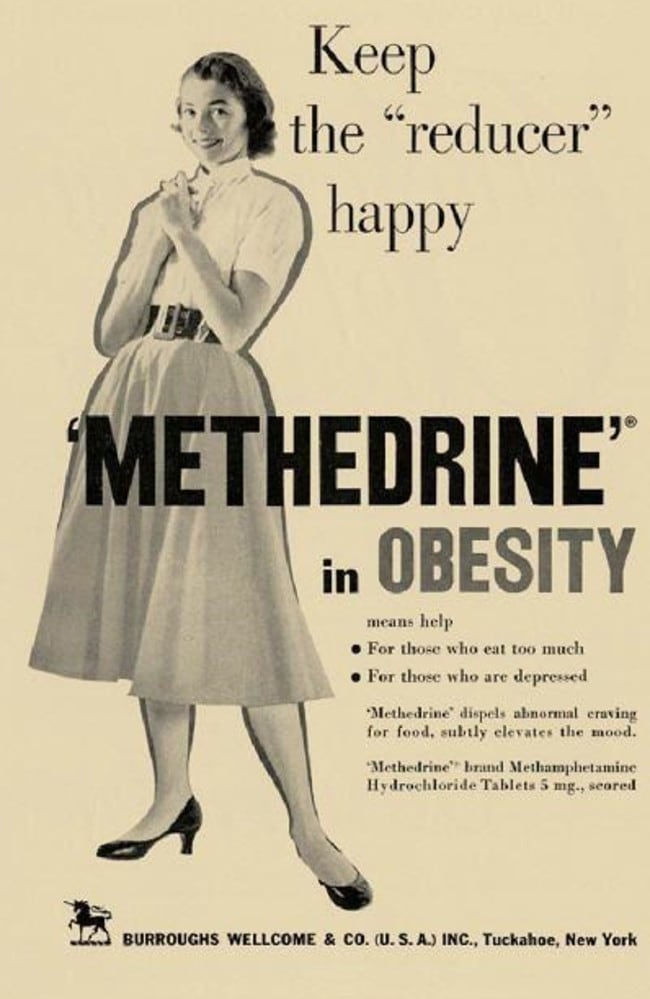
Methedrine was a brand-name for methamphetamine hydrochloride which is powdered meth — (as opposed to crystal meth or ‘ice’. But powdered meth can still cause psychosis, violence, depression and anxiety — what we called “speed” for a long time.
At one stage, you could even get an intravenous Methedrine injection from the doctor if you felt you needed it.
But who doesn’t need an injection of “optimism and co-operation”, right?
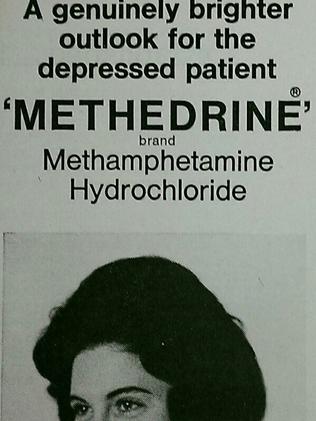
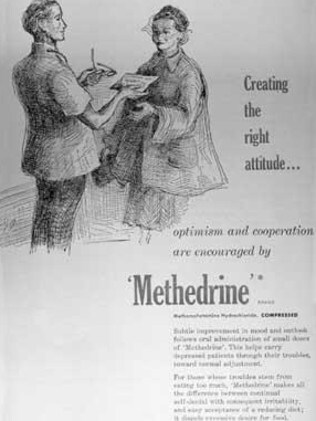
Methamphetamine hydrochloride was invented in 1919 Japanese science labs when chemist Akira Ogata combined some key ingredients with a formula made a few decades earlier.
In the 1940s Methamphetamine hydrochloride (powdered meth) was not just sold as Methedrine, but also as Norodin, “useful in reducing the desire for food and counteracting the low spirits associated with the rigours of an enforced diet”; Desoxyn, “for when she’s ushered by temptation”; and Syndrox, “for the patient who is all flesh and no will power.
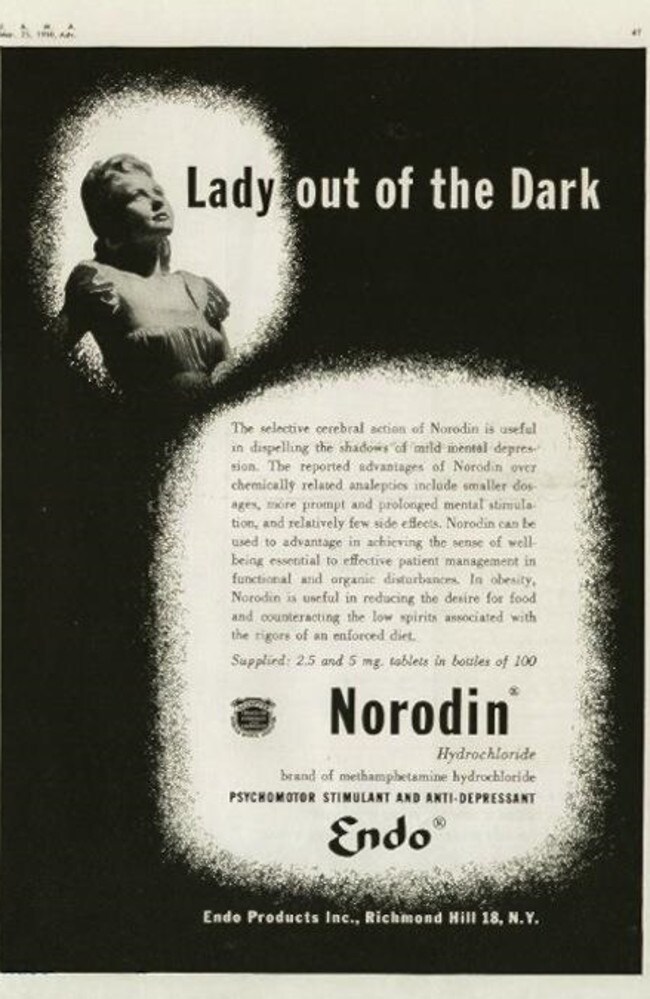
“But I just can’t resist desserts” — well, we won’t hold that against you greedy, weird 1940s side-hat-cleavage lady — try some Efroxine. After all it is “more likely to produce cerebral stimulation with relatively few side-effects” (little they knew).
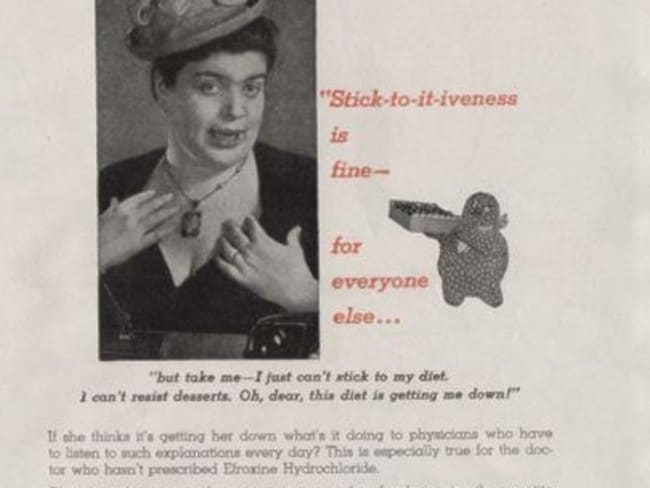
In the 1940s (before, during and after being used by the Nazi’s in the Second World War) Methamphetamine was sold all over the world as a treatment for obesity, depression, fatigue and colds.
BUT IT WAS BENZEDRINE THAT PROVED EVEN MORE POPULAR
In the late 19th century, Amphetamine sulfate (not methamphetamine, but similar — also sometimes referred to as “speed”) was developed in Romania.
Amphetamine sulfate was commonly sold under the brand-name Benzedrine. As you can see most of the time it was marketed to women — especially housewives.
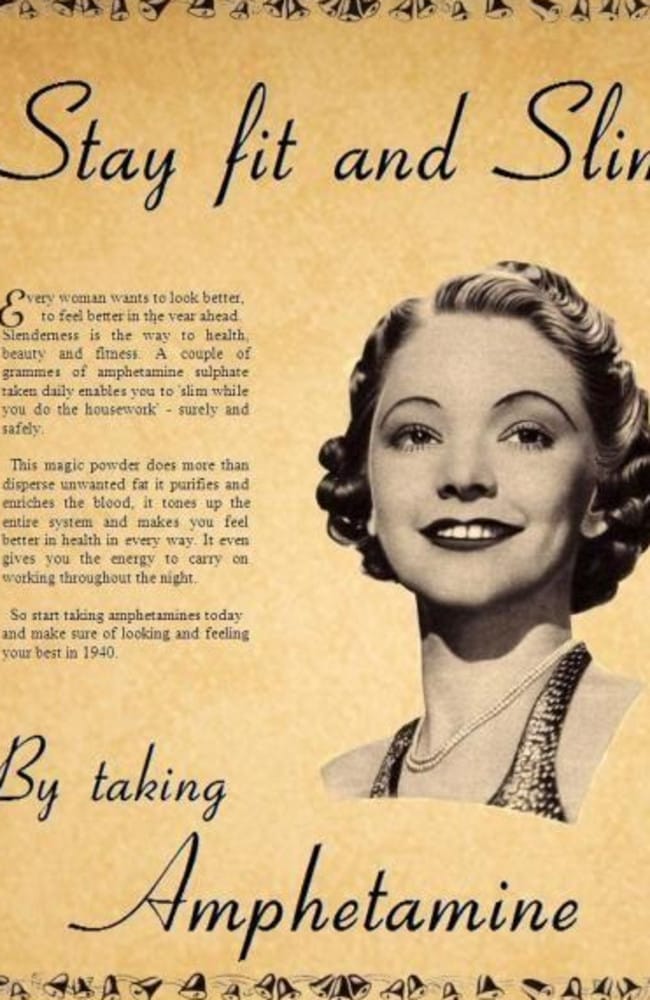
The big American pharmaceutical company Smith, Kline, and French (SKF) sold ‘Benzedrine’ in pills and inhalers. First sold as a decongestant, by the 1930s, the company was promoting it as a treatment for 33 different ailments, from alcoholism to erectile dysfunction.
This marked the start of a 20-year period in which amphetamines became the most commonly prescribed antidepressant in the western world.
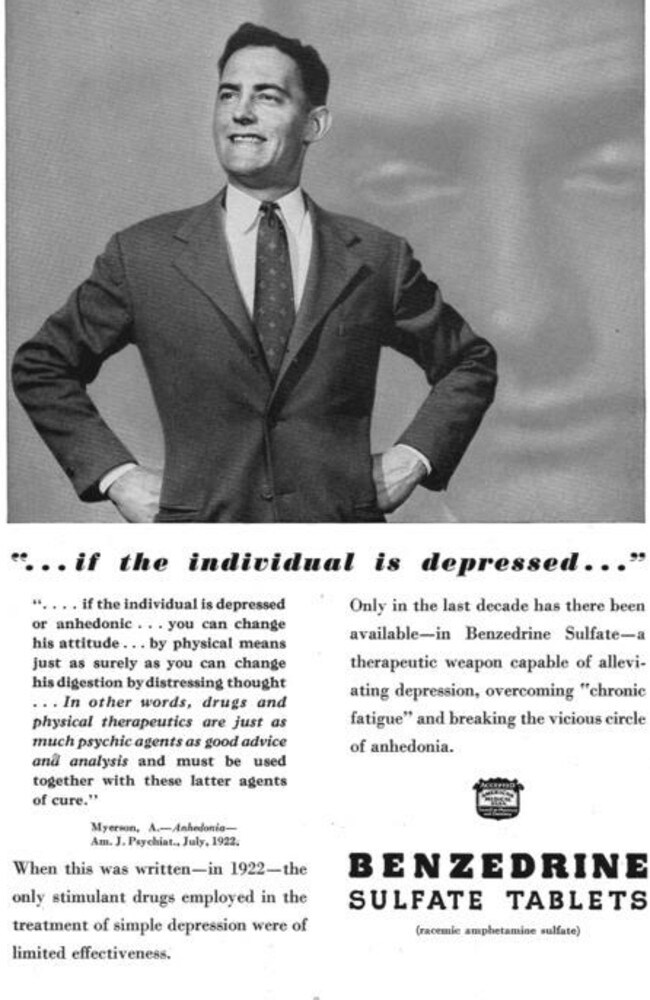
People even started getting high while they were, well, already high: Benzo inhalers started appearing on Pan Am flight menus in the 1940s, alongside cigarettes, drinks, and cocktails.
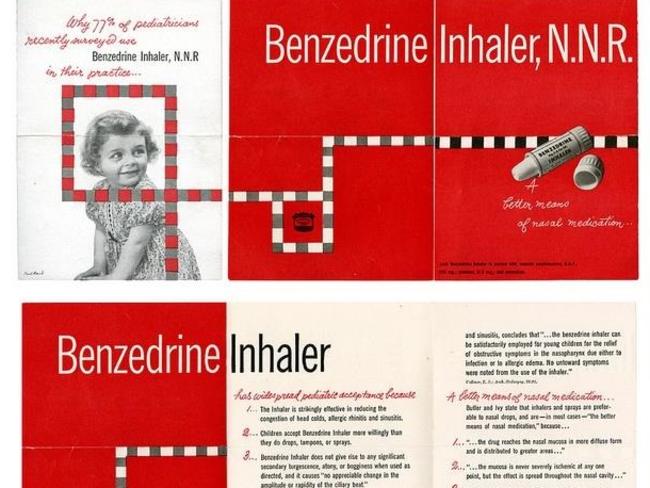
Australia embraced amphetamines. I found over 70 articles published about the drug in Australia throughout the late 1930s and early 1940s, all of which talked up the new-found happiness pill that also made you smarter.
No endorsement, though, compared to the one published in Adelaide’s The Mail on 15 May 1937: “Soon We Will All Be Brilliant”, the headline read.
Other newspapers ran articles saying “New Drug will Banish Shyness” and that Benzedrine is the “New Drug for Happiness.”
In his book Speed, Professor Nicolas Rasmussen from UNSW tells how “President John F. Kennedy received regular injections of a methamphetamine, together with vitamins and hormones, from a
German-trained physician named Max Jacobson. Jacobson would go on to treat ... Truman Capote, Tennessee Williams, and the Rolling Stones”.
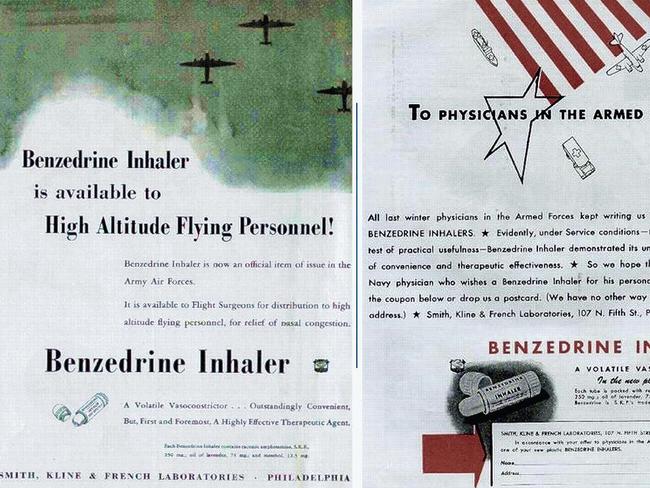
However, even by the late 1940s Benzedrine was becoming associated with deviancy both in America and here. In 1948, a New South Wales man was jailed for vagrancy, during the court hearing he admitted to taking 200 Benzedrine tablets a day.
A few months later, a 47-year-old telegraphist from Burwood, NSW, Arthur Haybe, was charged with murder, and told detectives he had used Benzedrine tablets “to keep himself awake in the early hours of morning” because he believed his wife “visited a neighbour at night”.
In October 1948, an unnamed 60-year-old mother of two Benzedrine addicts told reporters that her sons were taking up to 80 tablets a day, and said, “Benzedrine is slowly murdering my boys before my eyes. It is heartbreaking.”
AUSTRALIA’S FIRST METH SCENE
Moves were made to make the drug’s illegal — but not before Australia’s first meth scene developed. In the mid-1960s, Australian partygoers were taking Methedrine in the bright, new discotheque scene.
On 28 June 1967, The Canberra Times published an article titled “Night Spot, a den for drug addicts and criminals”, in which girls admitted to taking Methedrine and Dexedrine to “keep dancing or just to stay awake”.
MAKING METHAMPHETAMINE ILLEGAL
In the 1970s the United Nations created a major international treaty on drug prohibition. Australia would soon follow banning the sale of most meth and amphetamine products. America had done the same thing a few year’s earlier.
Meth production moved to the black market, and in particular biker gangs, which would later join up with Mexican cartels.
The Hell’s Angels first made amphetamine sulfate, then they realised they could make powdered meth far easier. Over time, these international drug gangs became richer.
Production moved to poorer nations. Over time they stopped making powdered meth and worked out to make crystallised meth (crystal meth is powdered meth crystallised); thus making the world’s strongest stimulant.
METHAMPHETAMINE IN AUSTRALIA TODAY
Today, the street slang for meth confuses the fact there are actually three distinct formulas: Amphetamine sulfate (once sold as Benzedrine); Ogata’s 1919 formula of powdered meth (sometimes called “meth” or “speed”) and “ice” (crystallised meth — but also called “meth” — the drug that is causing all the trouble of late).
Powdered meth has been available on the illicit drug market in Australia since at least the 1980s. We called it “speed” — but “speed” is really just powdered meth. So if you were taking ‘speed’ from the 90s onwards, you were actually taking meth.
Illicit crystal meth has been around in Australia since at least the late 1990s and has become increasingly popular.
The Australian Government’s 2013 National Drug Strategy Household Survey showed that use of the less potent powdered meth decreased significantly between 2010 and 2013, while the use of crystal methamphetamine more than doubled in the same period. It’s a trend that has continued.
Overall meth use has declined slightly in the last few years, but the shift to crystal meth use has meant the people who are using meth are using it more regularly. This means many more are becoming addicted and seeking medical help as a result. New research also shows the number of Australians dying from methamphetamine use is rising.
When you take any type of meth your dopamine (a motivation/arousal/reward brain chemical) and serotonin (your good mood brain chemical) levels jump and your noradrenaline (your anxiety brain chemical) levels drop.
When you come off the drug the opposite eventually happens — making you feel pretty ordinary. High levels of dopamine are also associated with a schizophrenics brains — that’s why crystal meth can cause psychosis. It also known that repeated meth use can make some users more violent.
In my personal experience the drug makes you egotistical, self-centred, grandiose and sometimes cruel.
Some users are drawn to the drug because it provides temporary relief from both anxiety and depression, but what was not understand mid last century was that amphetamines of all types only make
you feel worse in the longer-term; and that’s how addiction can start.
It’s quite extraordinary how it’s all panned out — isn’t it?
Source: http://www.news.com.au/lifestyle/he...s/news-story/b82f848ee30767a69ae6fff719f122da
It was mainly often under the brand-name Methedrine.
Methedrine was a brand-name for methamphetamine hydrochloride which is powdered meth — (as opposed to crystal meth or ‘ice’. But powdered meth can still cause psychosis, violence, depression and anxiety — what we called “speed” for a long time.
At one stage, you could even get an intravenous Methedrine injection from the doctor if you felt you needed it.
But who doesn’t need an injection of “optimism and co-operation”, right?
Methamphetamine hydrochloride was invented in 1919 Japanese science labs when chemist Akira Ogata combined some key ingredients with a formula made a few decades earlier.
In the 1940s Methamphetamine hydrochloride (powdered meth) was not just sold as Methedrine, but also as Norodin, “useful in reducing the desire for food and counteracting the low spirits associated with the rigours of an enforced diet”; Desoxyn, “for when she’s ushered by temptation”; and Syndrox, “for the patient who is all flesh and no will power.
“But I just can’t resist desserts” — well, we won’t hold that against you greedy, weird 1940s side-hat-cleavage lady — try some Efroxine. After all it is “more likely to produce cerebral stimulation with relatively few side-effects” (little they knew).
In the 1940s (before, during and after being used by the Nazi’s in the Second World War) Methamphetamine was sold all over the world as a treatment for obesity, depression, fatigue and colds.
BUT IT WAS BENZEDRINE THAT PROVED EVEN MORE POPULAR
In the late 19th century, Amphetamine sulfate (not methamphetamine, but similar — also sometimes referred to as “speed”) was developed in Romania.
Amphetamine sulfate was commonly sold under the brand-name Benzedrine. As you can see most of the time it was marketed to women — especially housewives.
The big American pharmaceutical company Smith, Kline, and French (SKF) sold ‘Benzedrine’ in pills and inhalers. First sold as a decongestant, by the 1930s, the company was promoting it as a treatment for 33 different ailments, from alcoholism to erectile dysfunction.
This marked the start of a 20-year period in which amphetamines became the most commonly prescribed antidepressant in the western world.
People even started getting high while they were, well, already high: Benzo inhalers started appearing on Pan Am flight menus in the 1940s, alongside cigarettes, drinks, and cocktails.
Australia embraced amphetamines. I found over 70 articles published about the drug in Australia throughout the late 1930s and early 1940s, all of which talked up the new-found happiness pill that also made you smarter.
No endorsement, though, compared to the one published in Adelaide’s The Mail on 15 May 1937: “Soon We Will All Be Brilliant”, the headline read.
Other newspapers ran articles saying “New Drug will Banish Shyness” and that Benzedrine is the “New Drug for Happiness.”
In his book Speed, Professor Nicolas Rasmussen from UNSW tells how “President John F. Kennedy received regular injections of a methamphetamine, together with vitamins and hormones, from a
German-trained physician named Max Jacobson. Jacobson would go on to treat ... Truman Capote, Tennessee Williams, and the Rolling Stones”.
However, even by the late 1940s Benzedrine was becoming associated with deviancy both in America and here. In 1948, a New South Wales man was jailed for vagrancy, during the court hearing he admitted to taking 200 Benzedrine tablets a day.
A few months later, a 47-year-old telegraphist from Burwood, NSW, Arthur Haybe, was charged with murder, and told detectives he had used Benzedrine tablets “to keep himself awake in the early hours of morning” because he believed his wife “visited a neighbour at night”.
In October 1948, an unnamed 60-year-old mother of two Benzedrine addicts told reporters that her sons were taking up to 80 tablets a day, and said, “Benzedrine is slowly murdering my boys before my eyes. It is heartbreaking.”
AUSTRALIA’S FIRST METH SCENE
Moves were made to make the drug’s illegal — but not before Australia’s first meth scene developed. In the mid-1960s, Australian partygoers were taking Methedrine in the bright, new discotheque scene.
On 28 June 1967, The Canberra Times published an article titled “Night Spot, a den for drug addicts and criminals”, in which girls admitted to taking Methedrine and Dexedrine to “keep dancing or just to stay awake”.
MAKING METHAMPHETAMINE ILLEGAL
In the 1970s the United Nations created a major international treaty on drug prohibition. Australia would soon follow banning the sale of most meth and amphetamine products. America had done the same thing a few year’s earlier.
Meth production moved to the black market, and in particular biker gangs, which would later join up with Mexican cartels.
The Hell’s Angels first made amphetamine sulfate, then they realised they could make powdered meth far easier. Over time, these international drug gangs became richer.
Production moved to poorer nations. Over time they stopped making powdered meth and worked out to make crystallised meth (crystal meth is powdered meth crystallised); thus making the world’s strongest stimulant.
METHAMPHETAMINE IN AUSTRALIA TODAY
Today, the street slang for meth confuses the fact there are actually three distinct formulas: Amphetamine sulfate (once sold as Benzedrine); Ogata’s 1919 formula of powdered meth (sometimes called “meth” or “speed”) and “ice” (crystallised meth — but also called “meth” — the drug that is causing all the trouble of late).
Powdered meth has been available on the illicit drug market in Australia since at least the 1980s. We called it “speed” — but “speed” is really just powdered meth. So if you were taking ‘speed’ from the 90s onwards, you were actually taking meth.
Illicit crystal meth has been around in Australia since at least the late 1990s and has become increasingly popular.
The Australian Government’s 2013 National Drug Strategy Household Survey showed that use of the less potent powdered meth decreased significantly between 2010 and 2013, while the use of crystal methamphetamine more than doubled in the same period. It’s a trend that has continued.
Overall meth use has declined slightly in the last few years, but the shift to crystal meth use has meant the people who are using meth are using it more regularly. This means many more are becoming addicted and seeking medical help as a result. New research also shows the number of Australians dying from methamphetamine use is rising.
When you take any type of meth your dopamine (a motivation/arousal/reward brain chemical) and serotonin (your good mood brain chemical) levels jump and your noradrenaline (your anxiety brain chemical) levels drop.
When you come off the drug the opposite eventually happens — making you feel pretty ordinary. High levels of dopamine are also associated with a schizophrenics brains — that’s why crystal meth can cause psychosis. It also known that repeated meth use can make some users more violent.
In my personal experience the drug makes you egotistical, self-centred, grandiose and sometimes cruel.
Some users are drawn to the drug because it provides temporary relief from both anxiety and depression, but what was not understand mid last century was that amphetamines of all types only make
you feel worse in the longer-term; and that’s how addiction can start.
It’s quite extraordinary how it’s all panned out — isn’t it?
Source: http://www.news.com.au/lifestyle/he...s/news-story/b82f848ee30767a69ae6fff719f122da




